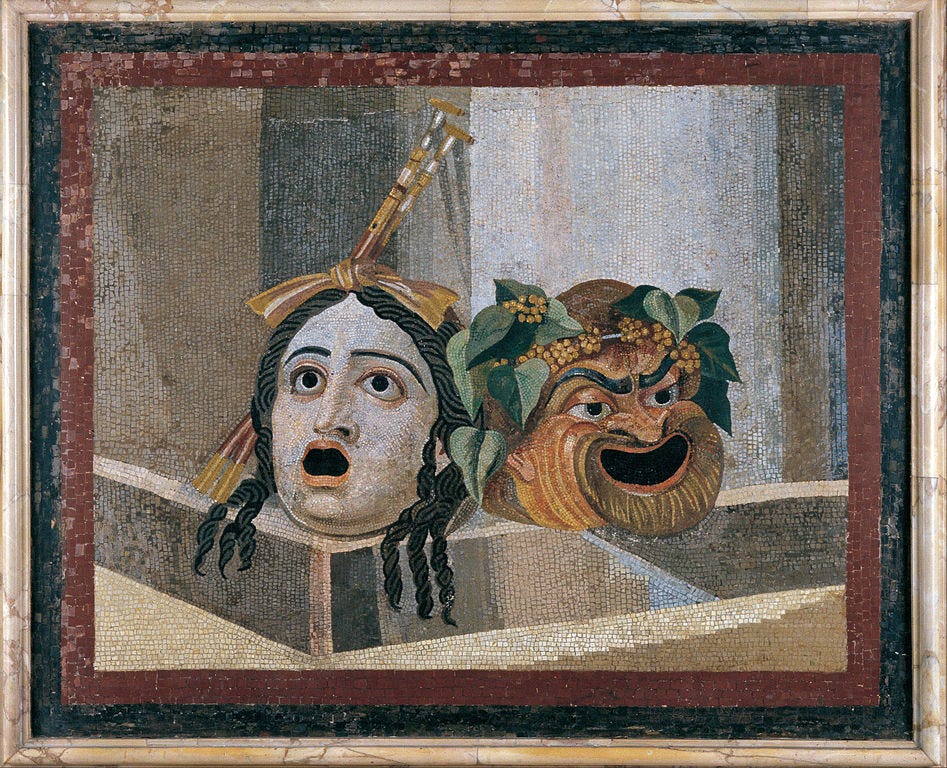Not all early states were autocratic.
 |
| Pericles, the leader of democratic Athens, revealingly portrayed wearing a military helmet. |
In 1970, anthropologist Robert Carnerio advanced the circumscription theory of the origin of the state. The idea being that in environmentally (and socially) circumscribed environments, population pressure leads to warfare between communities that ends up resulting in the violent amalgamation of villages into chiefdoms and chiefdoms into states. Carnerio argued that voluntarist theories of the state fail as smaller units would not give up their sovereignty voluntarily. The “penning in” circumscribing factors could be either physical (deserts, mountains, coasts) or social (complete occupation of arable land by other social units).
Carnerio identified clearly a problem with automatic theories of the origin of the state — that many farming communities did not produce any significant surplus. Though he mis-identified this as a social mechanism failure when in fact it the key constraining factor was whether the crops cultivated in a region were sufficiently seasonal to produce stored food that could be appropriated. That this was a necessary condition for the rise of chiefdoms and states can be seen by the case of New Guinea, which had all the farming, warfare and geographical and social circumscription one could want but never developed any chiefdoms as its entirely non-seasonal crops did not produce the stored food necessary for the required resource (i.e., tribute and tax) base for chiefdoms and states to develop.
Demographer Peter Turchin has added two elements to this model of the origin of the state: first, that power accrues to a group, not just an individual and second, that the cultural means to legitimate chiefly power had to evolve. I am not overly fond of the concept of legitimacy in descriptive analysis, but Turchin’s second factor can reasonably be reformulated as the normative support for chiefly power had to evolve so as to create patterns of systematic deference.
(My problem, building on political scientist Xavier Marquez’s critique, with the concept of legitimacy as a descriptive tool of analysis, is that once we have systematic deference plus analysis of norms, it is not at all clear to me what legitimacy as a descriptive term adds to the analysis. Any collapse in systematic deference can be successfully analysed without using legitimacy at all. The same applies to the development of systematic deference.)
More recently, Carnerio reformulated his theory, seeing physical and social circumscription as an accelerating rather than a necessary factor. Carnerio stated his reformulated theory succinctly as:
A heightened incidence of conquest warfare, due largely to an increase in population pressure, gave rise to the formation of successively larger political units, with autonomous villages being followed by chiefdoms, the process culminating in certain areas with the emergence of the state.
This might reasonably called the coercive-conquest theory of the origin of chiefdoms and states. Alas, this still has a problem: the evidence strongly suggests that conquest wars are a consequence of increased political centralisation, not a cause of it.
If we class wars as wars for plunder, wars for land and wars of conquest, then the wars of non-chiefly societies are overwhelmingly plunder wars while wars of state societies are overwhelmingly conquest wars, with the movement from wars for plunder →wars for land →wars of conquest being more a result of increased political complexity than a cause of it.
Another way to look at it is that the (social and physical) technology of aggression tended to develop ahead of the (social) technology of exploitation. It is only when the technology of exploitation develops sufficiently that war moves from the land and plunder wars of kill the men and boys, take the women, to the conquest wars of force the conquered men to provide taxes and labour service. But for that shift to take place there needs to be the level of social organisation that can achieve the systematic deference and appropriation of resources that we call conquest.
The period after the development of improved technologies of aggression, but before the development of sufficiently effective technologies of exploitation, created what is known as the Neolithic y-chromosome bottleneck, when most male lineages went extinct.
But the warfare theory of state origins can be reformulated without requiring conquest warfare to be the driver. As Carnerio himself has done:
Nonetheless, with each successive war, military leaders tended to enlarge their powers and entrench their position. Moreover, they became increasingly reluctant to surrender these powers when the fighting had stopped. Finally, either through a chief’s peremptory refusal to relinquish his once-delegated war powers, or (less likely perhaps) through the outright conquest of neighboring villages by the chief of the strongest one, the first permanent chiefdoms were established.
It then becomes what we can call the violent conflict theory of the origin of chiefdoms and the state. With the addition of systematic access to stored food to provide the necessary tribute-and-tax base, it has a great deal of evidence to back it up.
There are, however, two striking wrinkles: religion and autocracy. The majority of early states were autocratic. That is, they were dominated by polygynous rulers who sat at the apex of both military power and religious authority and who often functioned as both war leader and priest. Such rulers were typically both the pinnacle of human service to divinity as well as an avatar of divine authority.
The priestly or sacred role of early kingship points to the role of ritual and religion in the development of human cooperation and so the development of human societies. Ritual predates language (non-human animals engage in ritual). Ritual centres are the oldest free-standing human constructions. It is clear that ritual and religion was the other purpose, apart from warfare, for which resources could be collectively acquired and used at significant scale. (While exchange is at least as old as Homo sapiens, commerce as a mechanism for acquisition and use of resources on significant scale was a comparative historical latecomer compared to fortifications, palaces and temples.)
Ritual and religion, and the support of faith intermediaries (priesthoods, religious scholars, etc.), constitute a third pillar of states (along with coercion and resources), at least until recent centuries. Ritual and religion are also compatible with, and a feature of, all forms of government. They thus seem unlikely to be a key driver of differences in nature of states and the evolution of polities.
The wrinkle with autocracy is not all the early states were autocratic. On the contrary, in Mesoamerica, in the ancient Mediterranean, and in classical Northern India, there were a significant number of non-autocratic states. The band →chiefdom →state hierarchy of social complexity is complicated by the existence of more consultative societies. The Greek polis is an obvious example of such non-autocratic polities, but hardly the only one.
Access to resources, particularly appropriated (taxed) resources, and coercion are the two distinctive pillars of the state. They are mutually supporting pillars, as appropriation requires coercion and coercion is funded by appropriation. Indeed, there is a certain chicken-and-egg problem involved. This meant that the development of chiefdoms and states had to be something of a spiralling-up process as instruments of coercion and appropriation mutually scaled up.
In understanding the development of either autocratic or consultative polities, the question then becomes, regarding coercion and appropriation, how widely dispersed is leverage in each? It is a conspicuous feature of the city-states of the classical Mediterranean that citizenship and fighting for your city-state were intimately connected. If you needed the demos, the free poor, to row your war galleys, they had the leverage to gain the vote and you were a society where the demos had the kratos, the authority. If you were not a naval power, the demos typically didn’t have the leverage to gain the vote.
This association between fighting and bargaining leverage turns up elsewhere. The republics of northern India are sometimes referred to as Kshatriya republics. While the governing body of the republic of Tlaxcala was made up of warriors who had passed gruelling public ordeals. (As such public ordeals were tests of character and commitment, they were a reasonable way of choosing decision makers.)
Anthropologist Robert Blanton has developed a dual process theory of state politics, based on strategies of either elite network use seeking exclusory power or a more corporate strategy. I find it an inadequate analytical framework, precisely because bargaining power in polities has so often been based on coercive leverage.
Blanton is clearly, however, correct in that autocracy was not the only way early states were organised. Instead, there is something of a spectrum, across various mixtures of bargaining and dominance strategies.
Autocratic government was predominantly dominance, albeit often entailing implicit social bargains, typically based around differentiated capacity to resist various rules. Non-autocratic governments were based on explicit bargaining, though those outside the bargaining processes were still dominated by the state. (Democracy just meant that the explicit bargaining processes incorporated all free males.)
Dominance needs agents to scale up. Assembling and sustaining reliable agents is the key to successful autocracy. Provided that can be managed, unless explicit bargaining polities incorporate the representative principle, dominance-with-agents scales up far more than does bargaining politics. (I.e., without the representative principle, autocracy scales up more than does non-autocracy.) Across history, that which scales up generally dominates that which does not.
States and marriage patterns
Evidence suggests that the most favourable situation for developing non-autocratic states is societies with nuclear/conjugal families and where elite marriages are monogamous. A possible factor in generating this pattern is that polygyny leads to father-absent child-raising, which leads to more aggressive, dominance-oriented personalities among boys, with the effect being stronger the less co-wives cooperate.
Aggressive, dominance-oriented elite males is not a good basis for non-autocratic social arrangements.
Extended families are associated with more vertical (elder/younger) relations and dependency training, to ensure compliance with assigned tasks and dependence on the family, both of which discourage self-reliance. Again, not a good basis for non-autocratic social arrangements.
But there are differences in social dynamics between elite marital monogamy and elite polygyny, and between conjugal and extended families and kin groups, that are likely more important than these personality-development patterns.
Kin groups and extended families limit the role of bargaining, as they limit the ability of people to move between bargaining proposals and factional groupings. They also create intense loyalties that impede identification with the wider polity. That is particularly problematic for potential office-holders.
It is conspicuous that the three classical Mediterranean city-states whose constitutional history we know most about (Sparta, Athens and Rome) all worked to override kin groups.
Athens and Rome both abolished tribes based on lineage, turning tribes into strictly territorial categories based on where in the city you lived. So they replaced a kin identity with a territorial identity directly linked to the city. Similarly, everything about the raising of a Spartiate encouraged them to identify either with Sparta or with their comrades-in-arms based on age cohorts.
The linguistic evidence suggests that kin groups disappeared from Greek society as the polis became the dominant political form (though extended families lingered on in some rural areas), with the linguistic terms differentiating between male-side and female-side relatives largely dropping out of Greek in the fifth to third centuries BC. The disappearance of kin terms differentiating between who is, or is not, in the kin group is a powerful linguistic marker of the disappearance of kin groups. If the distinction no longer matters, you don’t need the associated terms in your language.
As for polygynous versus monogamous marriage, polygynous marriage is a manifestation of elite dominance as elite males acquire extra wives and concubines at the expense of low-status males. This creates a pool of low-status males without in-group marriage prospects who are likely to be a highly disruptive element in society, not invested in whatever bargains are agreed to.
The bandits that are such a notable feature of Chinese history and literature are a predictable product of a society with a highly polygynous elite whose low-status males had no chance of acquiring women from other societies. (Those people over there have women, steal theirs being a standard response to polygyny creating males without in-group marriage prospects; one displayed by the Norse going a-Viking, every pastoralist raiding culture ever and sanctified by Islam; notably in the “those your right hand possesses” verses in the Quran but also by comments in various hadiths and provisions within Sharia, topped off by the service of houris in the after-life.)
Given that social stability tends to increase wealth and income inequality, and such inequality tends to increase elite polygyny, as Chinese dynasties aged, the bandit problem tended to get worse. Bureaucratic corruption also tended to get worse over time, further undermining law and order. Peace and social stability meant that the population tended to increase, squeezing living standards. Given these patterns, that Chinese dynasties recurrently collapsed in an upsurge of banditry, secret society insurgencies and peasant revolts is not surprising.
Polygyny encouraged autocracy but also undermined it in various ways. Rulers with large harems surrounded by women and eunuchs in palaces that no un-castrated male could stay in overnight led to rulers isolated from their societies to a degree unheard of in the marital-monogamy West.
Elite polygyny also meant that marriage alliances had less value (as any wife or concubine might end up producing the heir) and created elite households that were divided against themselves, as wives competed for the prospects for their children. An elite male with a sole wife who was the mother of his legitimate children could use her as a partner and deputy in a way not open to an elite male with a collection of wives and concubines.
Conversely, a society that adopts monogamous marriage for elite males as well is already engaged in an implicit bargain, paying attention to the interests of lower-status males. This creates the basis for embedding more explicit bargaining into political arrangements.
With elite marital monogamy, there is no significant pool of men without marriage prospects to be socially disruptive. Fathers are much more likely to be involved in raising their children, leading to more self-reliant, but less aggressive and dominance-focused, sons.
Marriage alliances have more value, as an elite male’s (sole) wife is the presumptive mother of his heir(s). His wife becomes a partner and deputy, making it easier to invest in political bargaining.
There were, however, plenty of autocratic states among societies with marital monogamy. So, while elite male marital monogamy (and lack of kin groups) facilitated non-autocratic politics, they did not guarantee it.
Bargaining and leverage
We come back to the matter of leverage. A relatively small polity, not so large that bargaining was impractical, with a limited tax base that wished people to invest in their own military equipment and training, was likely to develop some form of political bargaining, which is to say citizenship, politics. This is still a state-origins-through-violence story, but one where the war leader does not become (or failed to remain) an autocratic ruler but instead evolved into officeholder(s) for a warrior-cum-citizen elite. This could mean a more group-oriented social form (as tribes can be) persisting all the way through the evolution of a state. Alternatively, the normal process of band →chiefdom →state could split off in a different direction.
An armed soldier-citizenry (or warrior-magnates) also has leverage over taxation, as their consent is going to be required to levy taxes. The one thing that historically was relentlessly deadly for bargaining politics was a ruler acquiring a tax base they did not need consent for. For a large enough tax base meant that citizen-soldiers could be replaced by professional soldiers. This is, after all, what happened to Rome. And to post-medieval Spain, which, upon the Spanish crown acquiring access to the gold and silver of the Americas, moved from being a pioneer of parliamentary politics to autocracy (albeit an increasingly inefficient and feeble one).
Of course, modern states have professional armies. What modern democracies rely on is the pervasive adherence to democratic norms, particularly (but not only) by the agents of the state. The hope and expectation is that no would-be autocrat will be able to assemble enough reliable agents to achieve dominance. Generally speaking, it is a case of so far, so good. Though the systematic attack in contemporary Western societies on bargaining politics via the attempt to control what it is deemed legitimate to express, including characterising particular (mass) voting choices as delinquent, is not a healthy trend for democracy. Especially as it is associated with attacks on the status and standing of citizenship. “Punch a Nazi” conveys a very different message than does “Nazis are citizens too”. If citizenship is downgraded, so is the citizenship one relies on your professional soldiers identifying with.
Be that as it may, it is clear that a presumption of autocracy cannot be a satisfactory basis for a good theory of the origin of the state. Yes, autocracy has been the most common path in the development of the state, but it has not been the only one.
Cross-posted from Medium.







